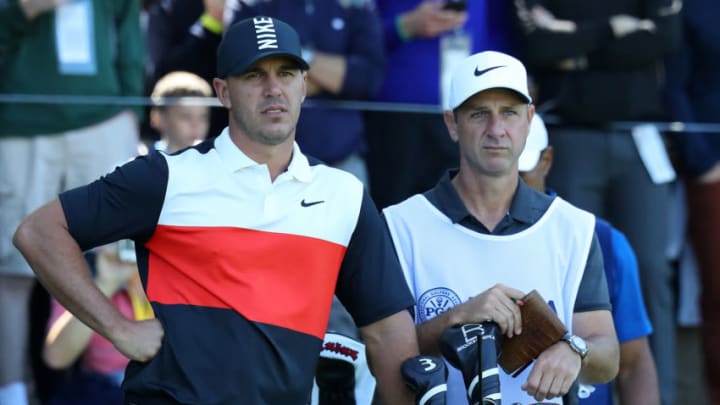The 2019 PGA Championship started the same way the 2018 edition ended – with Brooks Koepka looking nearly unbeatable. Now he’s got a real chance at history.
Brooks Koepka’s 63 in the first round of the PGA Championship guarantees him only a lot of attention Friday. With three rounds remaining to play, it says nothing specific or final about Koepka’s chances to actually win the tournament.
All the same, a 63 – on a day when the field average was nine strokes higher – is an awfully good start.
How good? Among those players positioned to make the cut, Koepka’s 63 stood nearly four standard deviations to the positive. That’s roughly a one-in-a-thousand occurrence. No matter whether he wins or not, he almost certainly will not maintain that level of dominance. Only four times in the approximate 450-event history of majors has a champion even managed to beat the four-round field average by 3.5 standard deviations.
Those four, by the way, were Davis Love at the 1997 PGA Championship, Tiger Woods at the 2000 U.S. Open (the men’s record at 4.10), Louis Oosthuizen at the 2010 British Open and Henrik Stenson at the 2016 British Open.
One reason to believe Brooks Koepka might be able to maintain something approaching that performance level for three more days is his track record. Koepka seems to have developed an ability to excel in majors.
His three recent victories – the 2017 and 2018 U.S. Opens and 2018 PGA Championship – testify to that. But so does his record in other recent majors. Beginning with that 2017 U.S. Open win, Koepka’s seven majors have included those three victories, a tie for second at the 2019 Masters, a tie for sixth and a tie for 13th.
His lone sub-par showing was a tie for 39th at the 2018 British Open, a result sandwiched between his U.S. Open and PGA Championship wins.
The average standard deviation of Koepka’s performance in those seven majors is about -1.50. To put it in less mathematical terms, for that seven-major stretch Koepka has out-performed about 88 percent of his competitors.
Who else has performed at that level over a similar period of time? It’s been done a couple of times and you’ll be familiar with the names.
During a seven-major stretch beginning with the 1999 British Open and continuing through the 2001 Masters – a stretch that encompasses the Tiger Slam – Tiger Woods averaged 2.46 standard deviations better than the fields against which he was competing.
Ben Hogan had a nice run. For the seven majors in which he played beginning with the 1951 Masters and continuing through the 1953 British Open, Hogan’s average standard deviation was 2.18 better than the average of his opponents.
More from PGA Championship
- 2023 PGA Championship: Winners and Losers at Oak Hill
- The bunker that changed the PGA Championship
- Reassessing Brooks Koepka’s status among the game’s greats
- PGA Championship Brings Signs of a Rory McIlroy Resurgence
- PGA Championship Has Drama, Charm, Disappointment and Uff Da!
Jack Nicklaus had a nice stretch or two. Between the 1963 British Open and the 1965 Masters, he averaged 2.25 for seven majors. Arnold Palmer? He averaged 1.79 better than the field between the 1961 British Open and the 1963 Masters.
So Koepka isn’t in that heady company yet.
I prefer to calculate peak performances based on the average standard deviation of a player’s 10 best majors from among the last five years. Applying that method, Koepka’s current peak score is -1.61. That ranks him in a tie for 76th among all players, men and women, across the eras. He’s in the company of fellows like Bobby Locke, Ben Crenshaw and Fred Couples. Considering that he is not yet 30, that’s a very nice start.
But if Brooks Koepka were able to post the kind of truly dominant PGA Championship he has set a course for this weekend, it could boost his peak rating into the 1.9 range. Were that to happen, he could project to climb as high as the fringes of the all-time top 15 for men, and the top 30 for all of golf history. He’d be closing in on Nick Faldo status.
It is too early to write that kind of speculation into stone. Less than a decade ago, many will recall, Rory McIlroy shot an opening round 63 at the 2010 British Open at St. Andrews. The next day, he followed his 63 with an 80 and eventually finished eight strokes behind Oosthuizen.
The famous St. Andrews elements played a substantial part in hampering McIlroy that Friday. The forecast calls for a windy Friday at Bethpage as well. There’s time to let Brooks Koepka demonstrate where, among the greats, he falls.
